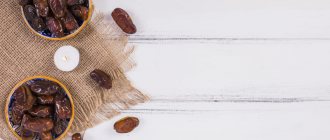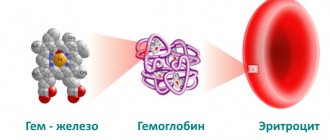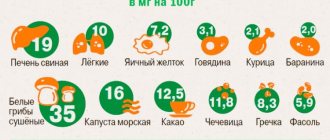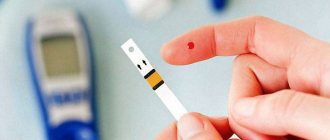Does buckwheat increase hemoglobin?
In terms of its beneficial qualities, buckwheat is a unique product.
The following beneficial substances can be found in its composition:
- Iron . It influences the formation of hemoglobin directly and the quality of blood formation.
- Ascorbic and folic acids . Promotes more complete absorption of iron.
- Omega-3 fatty acids . Strengthens the heart muscle and capillary network.
- Rutin . Provides density and elasticity of blood vessels.
Before you understand whether buckwheat increases hemoglobin or not, it is worth understanding the most complex iron-containing protein. It is part of red blood cells (erythrocytes) that supply oxygen to tissues. A decrease in the level of red blood cells leads to the development of anemia.
Important! The content of essential amino acids in buckwheat protein brings it closer to meat products. The absorption of buckwheat occurs much faster.
- Due to the lack of oxygen, the functioning of all systems and organs is disrupted, namely:
- the structure and appearance of the skin, nails, and hair deteriorate;
- headaches and fainting occur;
- limbs go numb;
- weakness appears for no reason;
- memory deteriorates;
- nervous reactions slow down;
- problems arise in the functioning of the heart and blood vessels;
- immunity decreases.
All these unhealthy conditions are partially corrected by raising hemoglobin. Regular consumption of buckwheat leads to an increase in the amount of this protein in the blood.
The effect of buckwheat on the body
Cereals contain a high amount of iron, but it is not absorbed by itself. In order for the body to perceive this microelement, it needs to be recharged with ascorbic and folic acid. These substances are also contained in buckwheat in sufficient quantities. The complex stimulates the functioning of the bone marrow, the production of red blood cells increases, and the level of hemoglobin increases. But this is not the only beneficial effect of a food product on the general condition:
- Maintains blood pressure levels by restoring blood supply.
- Due to potassium, it normalizes heart rate.
- Strengthens the skeletal system - contains a high amount of calcium.
- Rutin increases the strength of the walls and improves the tone of blood vessels.
- The B group of vitamins stabilizes the functioning of the nervous system, which has a general calming effect and helps cope with insomnia.
Attention!
Despite the fact that buckwheat flour dishes are used to increase hemoglobin, they can be consumed even if an increase is not required. Blood viscosity does not increase.
Regular introduction of cereals into the diet reduces the risk of developing coronary artery disease, heart attack and stroke, and reduces the likelihood of exacerbation of thrombophlebitis.
How to use buckwheat to increase hemoglobin in the blood
If there is insufficient amount of iron in the blood, doctors advise consuming buckwheat in different forms. Cereals are a hypoallergenic product that is not harmful to human health. Green, ground buckwheat, in combination with honey, kefir, and walnuts, is most beneficial for anemia. This use allows not only to increase the level of vital protein, but also to strengthen the heart and blood vessels.
Did you know? For its unique taste and high nutritional value in Rus', buckwheat was called the food of heroes. Commander Alexander Suvorov introduced this product into the soldiers’ diet.
In addition to eating buckwheat dishes, you should adhere to the following recommendations:
- drink up to 2 liters of clean water per day;
- avoid stressful situations;
- spend more time outdoors;
- “quit” bad habits;
- go jogging, swimming or other active sport;
- If possible, choose an ecologically clean region for permanent residence.
Buckwheat is used in many recipes. Soups made from it, cutlets, casseroles, and pancakes are especially popular. Sometimes they even prepare buckwheat pilaf and pudding. Below you can get acquainted with the methods of preparing buckwheat for use with low hemoglobin.
Ground buckwheat
To increase hemoglobin levels, it is recommended to consume buckwheat in crushed form (powder). When prepared, ground buckwheat resembles a puree. In stores today you can freely buy buckwheat flour, which is suitable for baking pancakes, pancakes and even bread.
Find out how to eat buckwheat if you have liver disease.
Recipe for making your own chopped buckwheat:
- Rinse the required amount of cereal, dry it thoroughly in a frying pan or in the microwave at a temperature not exceeding +50°C.
- Pour the product into a meat grinder or coffee grinder in small portions and grind.
- Take 1 tbsp daily. l. powder three times a day, washed down with 1/2 glass of water.
You can also make puree from this flour. To do this, you need to pour the product with warm water in a ratio of 1:3 and wait for it to swell. You can replace water with kefir, milk, yogurt.
With kefir
Reduced hemoglobin will help regulate an affordable dish with low-fat kefir. To prepare it you need half a glass of buckwheat and a glass of fermented milk drink.
Then proceed like this:
- In the evening, rinse the cereal.
- Fill it with kefir.
- Place in a cool place or refrigerator to infuse.
- Use in the morning on an empty stomach.
Green buckwheat
In its raw green “form,” buckwheat is the healthiest. It is rarely sold in stores, but can be found in markets. Since it does not undergo industrial heat treatment, it has 30% more nutrients than brown (fried). Prepare it according to the same recipes as regular one. The sprouted version of grains for adding to salads, baked goods, and drinks will be even healthier.
Important! Buckwheat contains a lot of vitamin B9, which increases the body's resistance to harmful environmental influences.
Germinate such a product according to the following plan:
- Select whole green kernels.
- Place them in a glass or porcelain bowl. The container should be shallow and wide.
- Rinse the grains several times.
- Fill the cereal with warm water - filtered or from a well.
- Cover the container with gauze.
- After three hours, the grains will swell and become twice as large. Rinse them.
- Place the kernels in a thin layer on the surface of the dish and cover with damp gauze. Cover the top with a lid, but make sure air gets in.
- Place the container in a warm place for 12 hours, then rinse the grains and leave for the same amount of time.
After a short period, sprouts will appear on the grains. The most optimal size of seedlings is 2-3 mm. It is these green kernels that you can add to various dishes. They can be put in the refrigerator, where growth will stop, and the raw materials can be used for several days.
With honey and walnuts
Buckwheat in combination with honey and nuts is simply a storehouse of nutrients. This combination will not only increase hemoglobin in the blood, but also strengthen the immune system. To prepare a healthy dish, take 0.5 kg of green kernels, 0.5 kg of peeled walnuts, and a glass of honey.
Did you know? And the USA does not have a culture of consuming buckwheat, but it is sometimes sold in stores. It is bought by tourists and emigrants from the CIS countries.
Next, prepare as follows:
- Cook crumbly buckwheat porridge.
- After cooling, add honey and chopped nuts.
- Mix everything thoroughly and start using it - preferably in the morning and no more than 100 g of product per day.
You can reheat the remaining porridge the next day. Experts advise not to cook buckwheat, but to leave it in boiling water for several hours. You can do this overnight by wrapping the bowl with grains in a towel. In the morning you only need to add the remaining ingredients to this porridge.
The benefits and harms of buckwheat for the body
Buckwheat is a unique product
Although buckwheat is often referred to as a popular grain, in fact it is not one, but is classified as a “pseudo-grain.” Buckwheat is a fruit seed, but because it contains many complex carbohydrates, it is often classified as a whole grain. This annual unpretentious herbaceous plant was brought from India. Buckwheat does not contain gluten, and its closest relatives are rhubarb and sorrel.
Buckwheat groats (kernels, prodel, flakes) are used in cooking. Buckwheat flour is added to baked goods, pancakes, and pasta.
In some countries, buckwheat leaves and shoots are eaten.
Unusual buckwheat recipes - HERE
.
The beneficial properties of buckwheat are entirely due to its components. In terms of its chemical composition, buckwheat is a valuable product that contains many important microelements.
Buckwheat also contains manganese, molybdenum, cobalt, nickel, titanium, selenium, iodine, silicon, sulfur, etc.
Buckwheat also contains a lot of vitamins: A, D, C, E, B1, B2, B3, B5, B6, B9 (folic acid), P (rutin), PP (nicotinic acid).
The amino acid composition of buckwheat is also rich. It contains the entire list of essential amino acids (those that are not synthesized in the human body, but come only with food): tryptophan, threonine, isoleucine, leucine, lysine, methionine, phenylalanine, valine, histidine.
100 g of raw buckwheat contains 330 kcal, proteins - 12.6 g, fats - 3.3 g, carbohydrates - 57.1 g, dietary fiber - 11.3 g.
Despite the benefits of this cereal, its use should be rational, since the energy value is quite high. You can assess the harm and benefits of buckwheat for a specific disease by consulting with a dietitian or nutritionist.
Where and how else are the beneficial properties of buckwheat used?
Buckwheat husks and seed shells of the grain are used as a hypoallergenic filler for children's orthopedic pillows and mattresses. Leaves and flowers of buckwheat are raw materials for the pharmaceutical industry. A unique drug, rutin (vitamin P), is extracted from them. In folk medicine, a healing decoction or infusion is made from buckwheat flowers and leaves.
How is buckwheat beneficial for the body?
Is buckwheat porridge healthy? Nutritionists recommend eating buckwheat 2-3 times a week to prevent various diseases of systems and organs.
- Heart health. Vitamins, microelements, fiber, polyunsaturated fatty acids and phospholipids contained in buckwheat collectively reduce cholesterol levels in the blood, regulate blood pressure, strengthen and increase the elasticity of the walls of veins and arteries, prevent the formation of blood clots and atherosclerotic plaques, reduce the risk of heart attack or stroke.
- Nervous system disorders. It is assumed that buckwheat helps improve the psycho-emotional state and normalize sleep. These effects are achieved due to the content of B vitamins, magnesium, manganese and the amino acid tryptophan. They participate in the natural production of the neurotransmitters serotonin and dopamine and soothe pain. This product is an excellent source of magnesium (100 g of cereal contains 231 mg Mg), which is very important for the functioning of the nervous system.
- Disorders of the gastrointestinal tract. The benefits of buckwheat for the stomach are as follows. Insoluble dietary fiber in buckwheat stimulates intestinal motility and promotes the growth and reproduction of beneficial microorganisms that inhabit the intestines. Organic acids in combination with magnesium and flavonoids help improve bile formation and bile secretion, stimulate the production of pancreatic juice. And phospholipids and amino acids help protect the liver. Soluble dietary fiber binds bile acids and removes them from the body naturally, thereby reducing cholesterol levels in the blood, which is extremely important in the prevention of cardiovascular diseases.
- Diseases of the musculoskeletal system. Buckwheat grain contains a large amount of minerals that help strengthen the bone-ligament system. These are calcium, phosphorus, silicon, copper, sulfur, zinc. In addition, some substances have a regenerating effect. These are carotenoids, flavonoids, vitamin E.
- Anemia. This is a condition of the body in which the level of hemoglobin in the blood decreases. Iron (6.7 mg per 100 g), B vitamins, rutin, manganese contained in buckwheat help prevent iron deficiency and B12 deficiency anemia. Despite the fact that iron is absorbed more efficiently from animal products, always remember the rule “the more varied the diet, the better.”
- Improving the condition of skin, hair and nails. Vitamins, microelements, rutin stimulate natural collagen synthesis.
- Boosting immunity, detoxification. During the period of colds, after an illness, it is useful to supplement the diet with buckwheat. In different forms, it is included in therapeutic diets (tables). Buckwheat helps cleanse the body of harmful substances, has an antioxidant effect, and increases the body's resistance.
- Blood sugar control. B vitamins, phospholipids, amino acids methionine, arginine and threonine help improve lipid metabolism and prevent the formation of fat deposits. Buckwheat is a source of resistant starch (that which is not converted into glucose in the intestines) and complex carbohydrates. They create a long-lasting feeling of fullness. Buckwheat is a good source of fiber with a low/medium glycemic index. This means that buckwheat is safe to eat for most people with type 2 diabetes. The load on the pancreas does not increase. In addition, again, it should be noted that buckwheat contains complex carbohydrates, so it raises and lowers sugar levels slowly, therefore, we feel alert and full longer and we are not tempted to overeat. Excess weight is a risk factor for the development of obesity, cardiovascular diseases and diseases of the musculoskeletal system.
The benefits of buckwheat for men
Buckwheat helps maintain male physical activity, increase endurance, and build muscle mass. The potassium, magnesium, phosphorus, calcium and vitamin E contained in buckwheat grains improve the functioning of the body's muscles. The amino acid arginine present in buckwheat stimulates the synthesis of muscle protein and also helps reduce fat deposits.
Buckwheat has a positive effect on blood circulation, strengthens blood vessels and the heart. Antioxidant properties protect men from diseases of the reproductive system.
The benefits of buckwheat for women
The mere presence of antioxidants and microelements in the composition helps improve the condition of hair and skin. In addition, buckwheat can prevent the development of varicose veins and strengthen bone tissue. It has a positive effect on the reproductive system. It is also recommended to use it in case of hormonal imbalances.
With age, a woman’s body experiences a decline in the hormonal function of the ovaries. Buckwheat is a good source of phytoestrogens; it can partially compensate for the lack of female sex hormones, thereby improving well-being.
The benefits and harms of buckwheat porridge for older people
In old age, special attention should be paid to the condition of the heart and blood vessels. The rutin component (vitamin P) acts as a vascular wall strengthener, iron helps normalize hemoglobin levels, and potassium supports heart function. It is also necessary to monitor blood sugar and cholesterol levels. Regular consumption of buckwheat porridge helps maintain the balance of these blood parameters. Is buckwheat good for sore joints? Definitely yes. The zinc and selenium present in cereals have a good effect on bone and joint tissues, which are subject to deformation with age. And rutin helps in the formation of collagen. But buckwheat porridge should be eaten without butter and sugar. Then the benefits of boiled buckwheat will be maximum.
Those with chronic kidney disease should eat buckwheat with caution. And, of course, this product should be limited in the diet according to the indications of the attending physician, if there are any contraindications.
The benefits of buckwheat for athletes and those who want to lose weight
Buckwheat, like other cereals, has a fairly high calorie content (330 kcal per 100 g). But, despite this, it is considered a “sports” and dietary product. Compared to other cereals, the fat and carbohydrate content in buckwheat is low, and the amount of protein is relatively high. This makes buckwheat, according to reviews from people leading a healthy lifestyle, a real superfood. Many athletes choose this product for “drying” muscles when they need to get rid of fat mass without losing muscle mass. Due to the content of polyunsaturated fats, buckwheat is useful for both sports and weight loss.
The benefits of buckwheat for athletes and those simply wanting to lose weight are significant. But you don’t need to use only it every day. Mono-diets pose a health hazard. Why neglect other nutritional components? This is unreasonable and even harmful. In addition to vegetable protein, animal protein is necessary for muscle development; it can be obtained from meat and fish. Vegetables and fruits are also rich in carbohydrates, fiber, minerals and vitamins. The diet of a person who cares about his health should be complete and balanced.
Read more about whether you can eat buckwheat every day HERE
.
The benefits of green and white buckwheat
First, let's figure out what the difference is between green, white and brown buckwheat. It's simple. Green buckwheat is buckwheat grain that has not been subjected to heat treatment. The main difference between white buckwheat is that it is briefly steamed before drying. Brown buckwheat, in addition to steaming, is also fried, so its color is more intense.
The benefits of green buckwheat for blood vessels are greater. The rutin content in it is higher, and it is the most valuable plant compound that helps strengthen the vascular and capillary network. There is 17 times more rutin in the shell than in the core. This is what gives buckwheat its green color. When the grain undergoes heat treatment, the buckwheat shell darkens and loses rutin. Therefore, the beneficial properties of white buckwheat will be higher than brown, but lower than green.
Is fried buckwheat healthy? Absolutely yes. Brown cereals are by and large no different from green cereals in terms of mineral, vitamin composition and nutritional value. Especially if you cook porridge from buckwheat (subject it to heat treatment). We will tell you further how to cook buckwheat correctly so that all the useful elements can be preserved to the maximum.
How to choose buckwheat correctly?
In stores you can find a wide range of this cereal:
- kernel – whole grain;
- prodel – crushed buckwheat, which cooks quickly and is suitable for making casseroles;
- flakes – flattened buckwheat kernels, used for quick preparation of baby porridges.
How to choose buckwheat in the store, read HERE
.
How to properly store cereals and flour - HERE
.
How to cook buckwheat for maximum benefit?
- Steaming. Of course, a minimally processed product is the most useful; it retains all micro- and macroelements. Therefore, it is worth paying attention to the method of steaming with water or milk, when the cereal is poured with hot liquid and left for an hour and a half, until it cools completely. You can try cooking buckwheat with kefir. To do this, raw washed cereals are scalded with boiling water, the water is drained and poured with kefir overnight. In the morning, a healthy breakfast is ready. You can add any fruits and berries to your taste.
- Soaking (followed by short cooking). Another way to prepare buckwheat with minimal processing. Place the washed grains in a saucepan and add cold water in a 1:1 ratio. Cereals soaked at room temperature swell and after a few hours are a semi-finished product that has retained all its nutrients. After soaking, you need to add a little more water and boil the cereal for several minutes, add salt. This side dish is ideal for meat, fish, chicken, mushrooms and vegetables.
- Boiling. To ensure that the cereal does not lose all its beneficial properties, it should be cooked for no more than 20 minutes. It’s better to reduce this time to 5–10 minutes, and then turn off the heat and cover the porridge with a lid and wrap it in a towel. Leave in such an impromptu bath for 1–2 hours. A multicooker is also suitable for this purpose.
- Roasting and baking. Fried and baked buckwheat is inferior to boiled buckwheat in terms of benefits. Frying involves a large amount of oil, which will increase the calorie content of the porridge. Baking is a long-term processing at high temperature. This cooking method will lead to loss of microelements and protein.
- Pastries, pancakes, pancakes. Of course, when buckwheat flour is added to the dough, the taste becomes more tart and the aroma becomes more spicy. But still, during prolonged heat treatment, useful elements are lost. Moreover, the presence of a large amount of sugar and fat in products does not make such food healthy and healthy. You should not eat such dishes often.
Why is buckwheat harmful and what are the contraindications?
There are no contraindications to consuming buckwheat. But you should not abuse this product, as there are some restrictions. For example, if you are prone to constipation and flatulence, it is not recommended to consume large amounts of fiber due to possible discomfort and bloating. But this only applies to buckwheat. In addition, people with impaired kidney function should not consume buckwheat more than 1-2 times a week.
Buckwheat and buckwheat flour are hypoallergenic products and therefore are often included in therapeutic diets.
But it is still possible for a food allergic reaction to this product to occur. Symptoms of buckwheat intolerance
:
- skin rash, itching, swelling;
- nausea, vomiting, diarrhea.
If an allergy occurs, you should consult a doctor for further treatment and observation. Most likely, you will need to take tests for allergens or do allergy tests. Buckwheat dishes may be prohibited during this period.
Follow the news, subscribe
mail.
When quoting this material, an active link to the source
is required
How to use it correctly
Experts have calculated that to compensate for the body's daily need for iron, it is necessary to eat 700 g of buckwheat per day. It is important to consider that the longer the product is subjected to heat treatment, the less iron will remain in it. It is also necessary to know about the characteristics of buckwheat consumption by different age groups.
For children
For young children under 4 years old, green cereals are recommended to increase hemoglobin. After such a hearty meal, children gain strength and energy, i.e. they gain vigor for the whole day. Buckwheat dishes are included in the menus of kindergartens and schools . Children are recommended to eat cereals at any time of the day. The metabolism of a child’s body is so fast that beneficial substances are absorbed instantly.
Pregnant and breastfeeding
Pregnant women are recommended to include buckwheat porridge in their diet to prevent oxygen starvation of the embryo. In the first half of pregnancy, the vital organs of the unborn child are formed.
Important! Flavonoids contained in buckwheat protect the human body from the growth of malignant tumors.
The normal course of the biological processes of the fetus is affected by folic acid and amino acids coming from foods. Buckwheat also quickly satisfies frequent attacks of hunger in expectant mothers. It is better for women to cook cereals with the addition of low-fat kefir.
For adults
A serving of buckwheat porridge for an adult per serving should be 100–150 g. It is good to combine it with vegetables. You can prepare the porridge according to any recipe described above and consume it daily.
Did you know? The yield of buckwheat, compared to rice, is low. From one hectare you can harvest 60 quintals of rice and only 10 quintals of buckwheat. Almost half of the world's total crop harvest comes from Russia.
Contraindications
It is worth remembering that the absorption of iron from foods is impaired when taking certain foods at the same time. You cannot drink tea, coffee, or milk with buckwheat.
- You should not eat buckwheat porridge in the following cases:
- Diseases of the stomach and intestines (gastritis, ulcers). Buckwheat must be well steamed and brewed so that it is easier to digest.
- Low blood pressure. Due to the high content of magnesium in the product, the walls of blood vessels relax and the pressure in the blood vessels sharply decreases.
- In case of individual intolerance to the product.
Research shows that there are no particular contraindications to the use of buckwheat to increase iron levels in the blood. The main thing is to cook it correctly, without haste, so that every grain swells and softens. The finished dish will be absorbed to the maximum and will bring exceptional benefits.
Features of use for children and pregnant women
There are only a few people who are allergic to buckwheat. The structure of the product is hypoallergenic; it is recommended to be included in the diet for diseases of the digestive tract, for patients after surgery, as a first complementary food. Consumption during pregnancy prevents a decrease in hemoglobin levels due to iron, normalizes the formation of the neural tube and nervous system of the fetus due to folic acid, and increases immunity thanks to vitamin C.
If you prepare dishes from buckwheat or grinding - porridge with water or milk, add it to baked goods, you do not need to inform the gynecologist. When introducing raw grinding into the daily menu, you should consult your doctor. This addition to the diet increases the load on the digestive organs, and in combination with honey, it increases blood sugar levels. In pregnant women, metabolic processes change, and gestational diabetes may develop. In order not to provoke a deterioration of the condition, it is better to fill the grinding with kefir or water.
Contraindications to increasing hemoglobin levels with buckwheat are:
- gastrointestinal diseases at the acute stage - raw buckwheat flour or poorly cooked cereals are poorly digested and can cause intestinal spasms;
- hypotension - high magnesium content causes a decrease in blood pressure;
- with allergies - they are rare, but they can occur.
If the lack of hemoglobin is due to dysfunction of the hematopoietic system or malabsorption, the problem cannot be solved without medications. But this does not mean that you have to give up buckwheat. This useful product will help stabilize your general condition.











